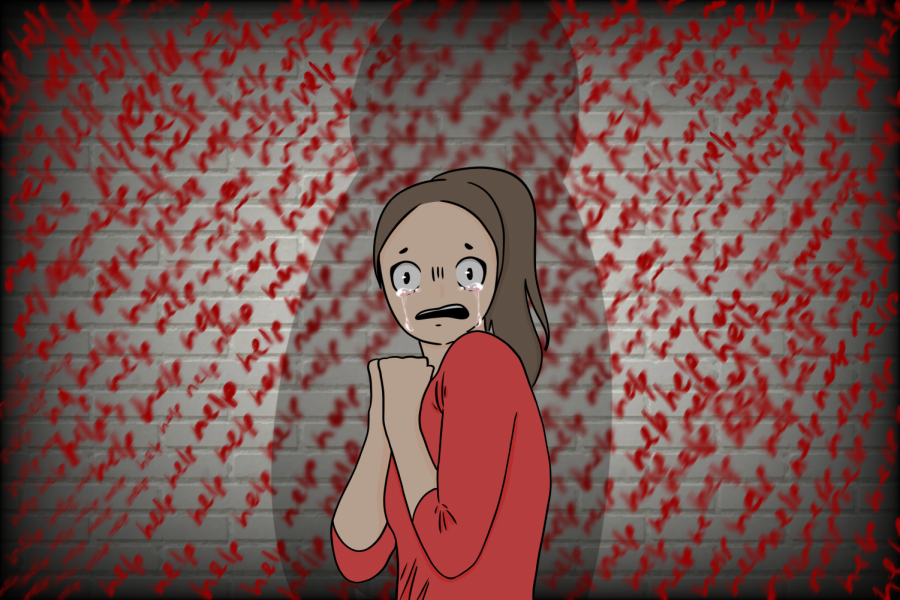I could still hear the distant boom of fireworks long after my parents had gone to bed. Despite the tensions surrounding the pandemic, my family’s New Year’s celebration was still filled with copious amounts of food, dinner discussion, and laughter. Content to stay up a while longer, I sat with my sister and her friend on the living room floor, where we continued our quiet chatter about the year ahead. In the dark, I heard my sister’s friend murmur:
“So… what are you most excited about?”
“Excited? About what?” I asked.
“College! It’s your senior year, yeah? There’s gotta be something that you’re looking forward to.”
She was right. Just the thought of getting to venture into a new city on my own and start a new chapter sent my stomach into a pleasant frenzy of butterflies. I told her my thoughts, and she nodded in approval.
“What about things you’re nervous or scared about?”
I hesitated. Just like her last question, I immediately knew the answer, but I didn’t want to say it outright, afraid of making things awkward and ruining the comfortable banter we’d fallen into. But I also knew that if I told the truth, maybe she would quell my worries. So I answered, very slowly:
“Getting, you know… sexually assaulted?”
Half expecting her to laugh, I inwardly cringed. But she didn’t. Nor did she give me a puzzled look or say that I was just being paranoid, that things like that don’t happen as often as you might think, which in some ways, was even worse than being laughed at. Instead, without a hint of humor, she simply replied, “Yeah, that’s valid.”
After weeks of thinking about that incident, I’ve realized that my fear stems far deeper than the thought of getting backed into a corner at a party and losing control. It’s the deep-seated fear of emerging from the childhood “safety bubble” I’ve been raised in. And while it’s certainly normal to be nervous about entering the adult world for the first time, it’s hard to deny the fact that there’s a growing culture of fear in this country as a whole, a constant sense that the world is becoming more unsafe by the year.
The inherent trepidation our generation has towards entering adulthood is caused not solely by what The Atlantic writers Jonathan Haidt and Greg Lukianoff called “coddling” of the American youth (the idea that adults shield children from all traumatic or offensive situations to an unhealthy extent), but also by the media storm that has surrounded us. The question is: is the “fear culture” a warranted and reasonable response to changing times? Or are we simply blowing the numbers out of proportion?
To answer that question, we need to trace the history of “fear culture” back to its inception and understand it at its source. According to Haidt and Lukianoff’s article, appropriately titled “The Coddling of the American Mind,” a national sense of paranoia took root back in the 1980’s, when photos of missing children began popping up on the sides of milk cartons. Naturally, “baby boomer” parents began reining in their children off the streets, and the era of “free-range parenting” gradually came to an end over the next few decades. While the authors largely intended for this protective urge to serve as the context for the growing hypersensitivity to “microaggressions” among college students, it is also linked to undeniable anxiety toward the seemingly crime ridden world we live in.
And can you really blame the parents? Each day, we are bombarded with an endless stream of media chock-full of overnight robberies, horrific homicides, and accusations of sexual assault. On cable news and search engines like MSN, seeing mugshots of men and women captioned with the latest local incident of domestic abuse or hit-and-run is not uncommon. And as blunt as it might sound, maybe we also have ourselves to blame for this madness, be it journalists’ desperation to publish riveting and “newsworthy” content, or our own morbid fascination we experience as the readers.
Still, according to school psychologist Mrs. Danielle Perkins, there’s a fine line between harboring the “good” kind of fear (i.e. the kind that keeps us safe from potential danger) and letting anxiety take over.
Generally speaking, she says that “it’s good practice to always go out with someone at night when you’re walking in the dark. Where it becomes debilitating is when it becomes irrational, [when] you’re not experiencing the things you need to be doing: you’re not going to your night classes, [or] you’re not going to the library,” for example.
While that anxious feeling might seem hard to shake, she explained that there are a couple of habits you can use to learn how to “control the controllables”: 1) taking charge of your body language (your posture, etc.) and 2) shifting towards a more positive mindset when forced to confront potentially dangerous situations. For example, Mrs. Perkins explained that rather than automatically fearing the worst when walking home in the dark, you might reassure yourself that you will be safe as long as you travel with a friend.
But perhaps the strongest remedy to facing anxiety head-on, particularly when it comes to social media, is taking the news with a grain of salt. That’s not to say we ought to invalidate the crimes that are brought to our attention; it merely calls for a shift in perspective, a willingness to see more than one side of the news spectrum and investigate the facts.
Despite the increasing prevalence of crime-related news, the overall crime rate in the US is actually falling at a fairly steady rate. Indeed, a graph from the FBI’s Crime Data Explorer (a database of nationally reported crimes dating back to 1980) illustrates that the rate of violent crimes per 100,000 people–including homicide, rape, robbery, and aggravated assault–are at an all-time low. Compared to the early 1990’s when crimes peaked at around 752 cases per 100,000, that number has nearly halved as of 2019, with only 379 cases per 100,000.
Property crimes such as arson, larceny-theft, motor vehicle theft, and burglary have shown similar trends over the past three decades. With an all-time high of 5,140 per 100,000 people in 1990, overall numbers have dropped to 2,109 (approximately a 59% decrease) by 2019.
In regards to sexual assault in particular, a total of 64,048 offenses were reported to law enforcement in 2019. Of that, only 450 cases (0.7%) were said to have occurred on college or university grounds.
Still, there’s an important caveat to these records: while they are the most up-to-date available, it is realistically impossible to track every single crime that is committed each year. Keep in mind that these statistics were strictly calculated from cases that were reported to police or other law enforcement agencies, which suggests that it’s more than likely the rates are higher than they appear. To exactly what extent, however, is unknown.
According to Social Problems: Continuity and Change published by the University of Minnesota, these unreported cases (coined collectively as “the dark figure of crime”) are notoriously hard to quantify, not only because of a lack of official police records, but also from the surprisingly variable definitions of certain offenses.
For instance, in 2013, the offenses categorized as rape or sexual assault were changed to include a more broad definition, which outlines not only the “forcible” violation of females but also of males, as well as any sexual acts performed toward another person without consent.
Now at this point, you might be wondering whether any of the information you come across is trustworthy; after all, if both news and official police reports harbor their own “dark figures” and myths, then what else is there to turn to?
While the news definitely keeps us on the lookout for possible ‘stranger danger,’ it’s important to remember that TV screens don’t always serve as a window into reality.
For senior Emma Craig, it ultimately comes down to finding balance between what you hear from the media and trusting your own gut to keep you safe.
“I think it’s really important that [these incidents] are on the news, and that people are aware that they are happening,” she said. “I do think that the frequency at which we’re hearing the number of cases can make it a little bit discouraging, in a way.” However, she reasoned that the statistics aren’t going to keep her from exploring what her new home has to offer.
As a New York native who has recently been accepted to the University of Miami, Craig knows the potential dangers that come with living in a big city, especially as a young woman. She admitted that while she definitely feels “more vulnerable as a female” when going into town, she is prepared to travel “in groups of three to four plus people, preferably with one male, just to be safe.”
So is the news our enemy in the long run? In truth, it’s a double-edged sword. While it definitely keeps us on the lookout for possible “stranger danger,” it’s important to remember that TV screens don’t always serve as a window into reality. The true nature of crime may never be known for certain, but we cannot let that uncertainty rule our lives or prevent us from traveling beyond the “safety bubble” of our childhoods.
With just two months remaining of my senior year of high school, college has practically occupied all of my thoughts. As much as I’ve come to call this school and this town home, there’s a part of me that can’t help but daydream of venturing out into an unfamiliar city with unfamiliar people. More often than not, when I wake up each morning, the unknown prospect of what’s to come next sends me buzzing with excitement.
This story was originally published on The Gauntlet on April 7, 2021.































![IN THE SPOTLIGHT: Junior Zalie Mann performs “I Love to Cry at Weddings,” an ensemble piece from the fall musical Sweet Charity, to prospective students during the Fine Arts Showcase on Wednesday, Nov. 8. The showcase is a compilation of performances and demonstrations from each fine arts strand offered at McCallum. This show is put on so that prospective students can see if they are interested in joining an academy or major.
Sweet Charity originally ran the weekends of Sept. 28 and Oct. 8, but made a comeback for the Fine Arts Showcase.
“[Being at the front in the spotlight] is my favorite part of the whole dance, so I was super happy to be on stage performing and smiling at the audience,” Mann said.
Mann performed in both the musical theatre performance and dance excerpt “Ethereal,” a contemporary piece choreographed by the new dance director Terrance Carson, in the showcase. With also being a dance ambassador, Mann got to talk about what MAC dance is, her experience and answer any questions the aspiring arts majors and their parents may have.
Caption by Maya Tackett.](https://bestofsno.com/wp-content/uploads/2024/02/53321803427_47cd17fe70_o-1-1200x800.jpg)
![SPREADING THE JOY: Sophomore Chim Becker poses with sophomores Cozbi Sims and Lou Davidson while manning a table at the Hispanic Heritage treat day during lunch of Sept 28. Becker is a part of the students of color alliance, who put together the activity to raise money for their club.
“It [the stand] was really fun because McCallum has a lot of latino kids,” Becker said. “And I think it was nice that I could share the stuff that I usually just have at home with people who have never tried it before.”
Becker recognizes the importance of celebrating Hispanic heritage at Mac.
“I think its important to celebrate,” Becker said. “Because our culture is awesome and super cool, and everybody should be able to learn about other cultures of the world.”
Caption by JoJo Barnard.](https://bestofsno.com/wp-content/uploads/2024/01/53221601352_4127a81c41_o-1200x675.jpg)






